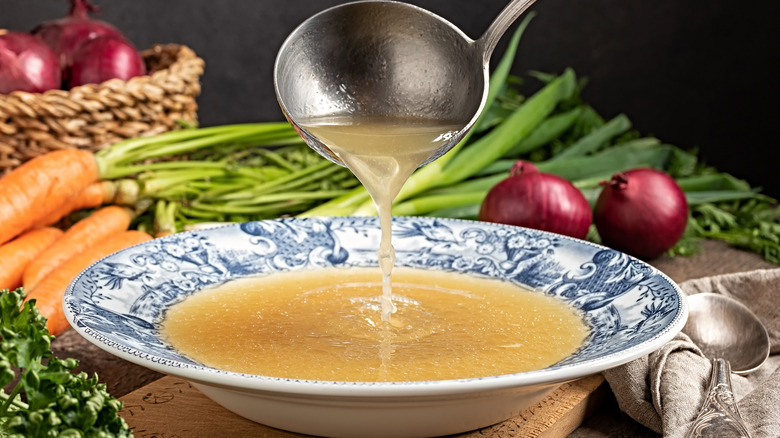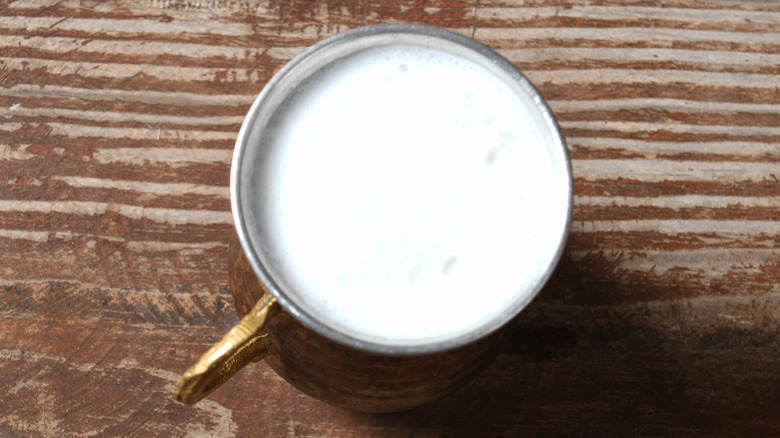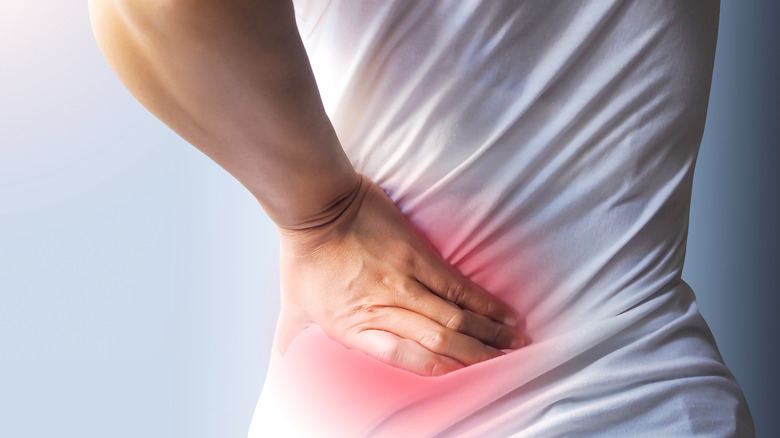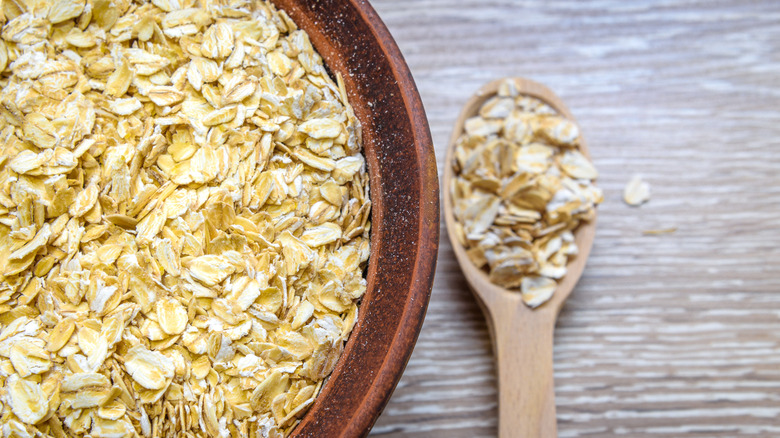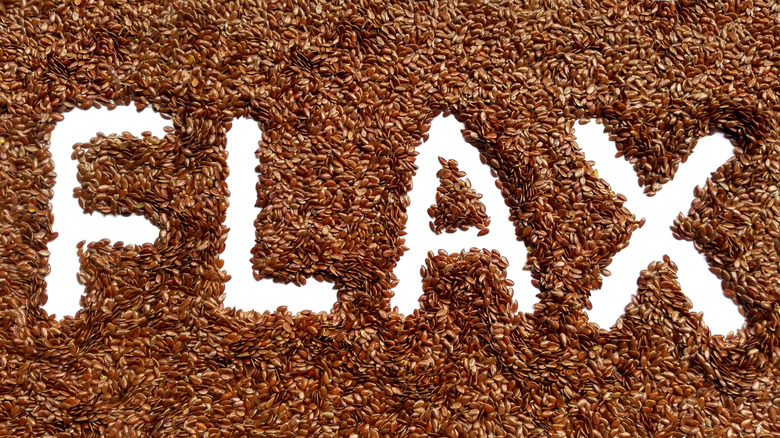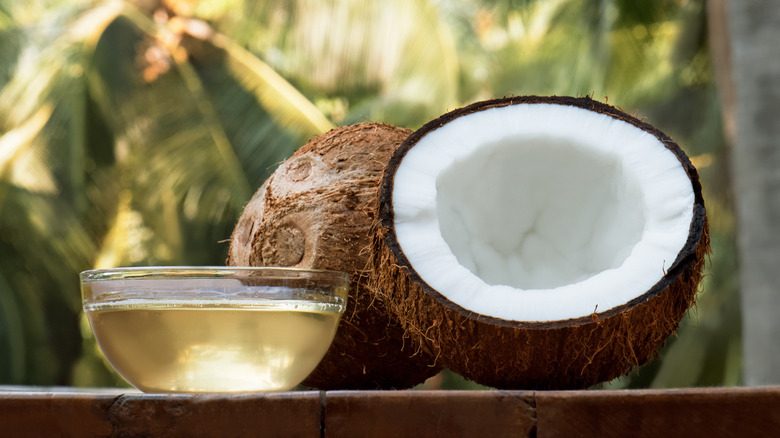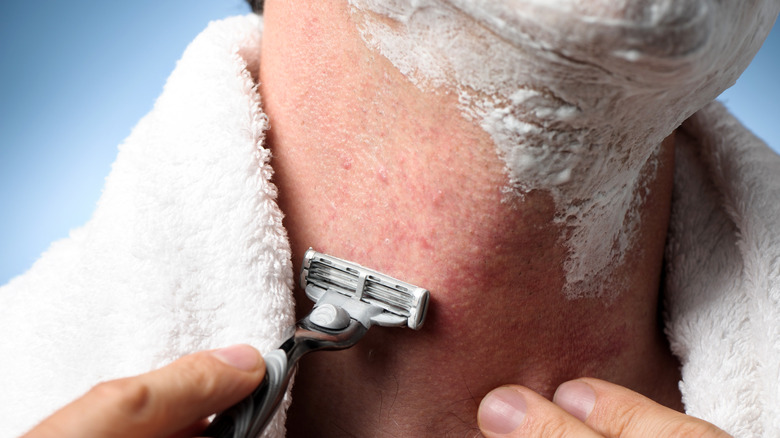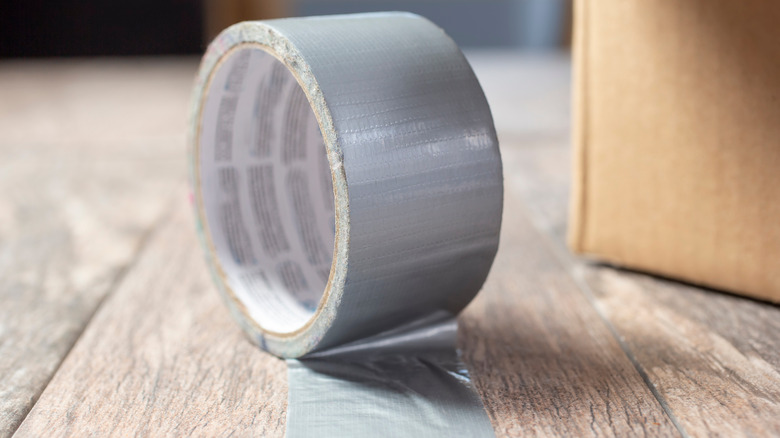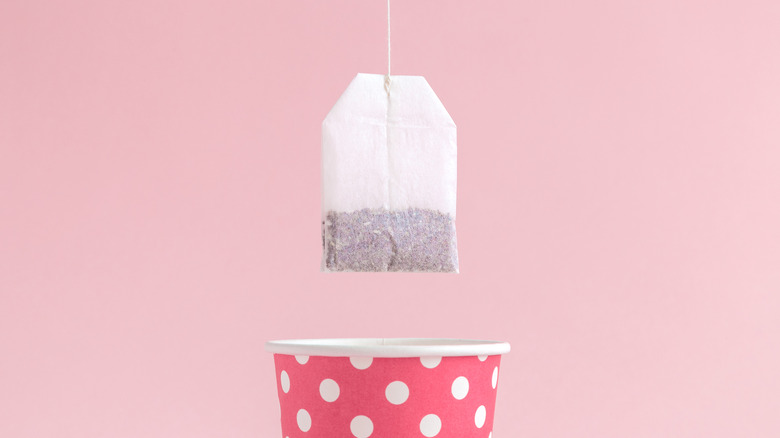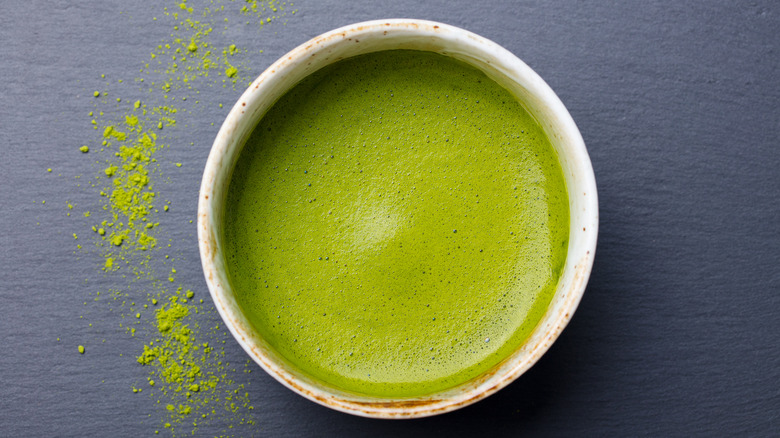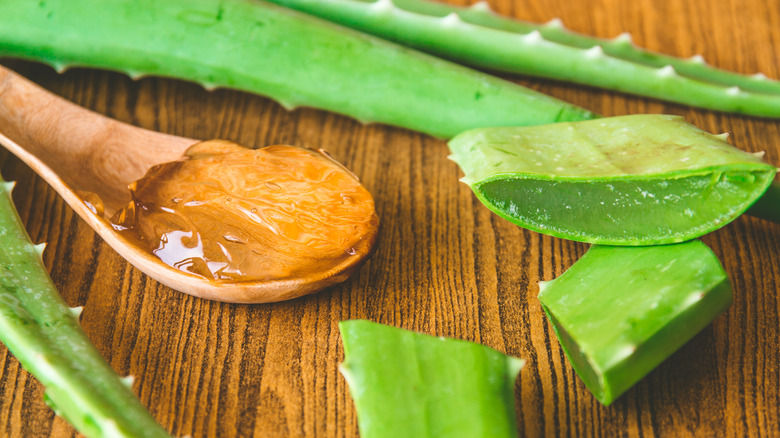Home Remedies That Actually Work
No doubt you've heard of the book series "Chicken Soup for the Soul." Even if you've never read one of its titles, you can probably guess what it's about and why people buy into it. It all ties back to one of the most popular and joked about home remedies. As we've been told since we were children, you should eat chicken soup when you're sick. Is it a cure? No, but somehow it helps you feel a little better.
It's easy to dismiss chicken soup as nothing more than comfort food. But not so fast. As Medical News Today noted, there is scientific data to back eating this type of soup when you're ill. As it turns out, the properties in chicken soup actually help to reduce inflammation and how mucus moves in your body. Plus, eating soup can help you stay hydrated, which can be a major concern when you're under the weather. And what about that soothing feeling it gives you? As Sandy Allonen, a clinical dietitian, told WebMD, "Chicken is also high in tryptophan, which helps your body produce serotonin that can enhance your mood and give you the feeling of 'comfort' that helps make chicken noodle soup a true comfort food."
Yes, chicken soup is a true home remedy that can offer real help with a health issue, but it certainly isn't the only home remedy you may want to consider for what ails you.
Buttermilk can lighten age spots
While butterflies and buttercups have no connection to butter, buttermilk is, shall we say, butter adjacent. This liquid, which is formed after milk or cream is churned into butter, is a popular ingredient in everything from biscuits to chicken dishes. Used topically, however, and suddenly buttermilk becomes an effective way to get rid of age spots.
According to AARP, the lactic acid, vitamin B12, and vitamin D in buttermilk can help to lighten the skin, as well as get rid of dead skin cells. In addition, it contains vitamins B6 and A, as well as biotin, which can rev up your body's collagen levels. And as eMediHealth explained, collagen helps keep your skin tone even.
AARP recommends using cotton balls to apply buttermilk to age spots. Leave it on your skin for roughly 20 minutes before washing it off with plain water. You can continue this process on a daily basis, especially since buttermilk tends to be less expensive than beauty products that advertising how they can reduce the appearance of age spots. However, eMediHealth cautions that some people do have a negative reaction to using buttermilk topically and so recommends testing it on a small patch of skin that is not located on your face. If you find you cannot use buttermilk, you may want to try yogurt or regular milk, which can also help with lightening age spots.
Have back pain? You might want to try comfrey
Although this flowering herb with hairy leaves is poisonous if consumed, research is finding that comfrey is an effective pain reliever when applied topically. A study published in the British Journal of Sports Medicine found that people ages 18 through 60 who applied an ointment that contained extract made from the root of the comfrey plant experienced less upper and lower back pain than those who used ointment not containing comfrey at all (via WebMD).
"Comfrey root extract shows a remarkably potent and clinically relevant effect in reducing acute back pain," the authors of the study wrote. It is important to note that even though all the participants in this study experienced back pain, none of them attributed that pain to a specific medical issue like trauma to their back or a slipped disc. In addition, this study was funded by the drug company Merck. With that said, earlier research found similar results, regarding comfrey and relieving pain caused by arthritis in the knees and sprained ankles.
Although the comfrey root extract was effective in reducing pain, it did also cause some side effects, including eczema, nausea, and nasal discharge (via WebMD). So, before using comfrey, you should speak with your health care professional. Also due to the toxic nature of the plant, you should thoroughly wash your hands after handling it or any products containing it.
Take the itch out of mosquito bites with oatmeal
For most of us, oatmeal is a warm comfort food, perfect for breakfast on a chilly morning. But this tasty meal is actually an effective treatment against bug bites especially the kind caused by mosquitos (via Healthline). According to a study in the Archives of Dermatological Research, oatmeal contains chemicals called avenanthramides and polyphenols, which can help take the swelling and itch out of mosquito bites.
To make this home remedy, mix plain oatmeal with water, adding water until the oatmeal paste is about the consistency of spackle (via Healthline). Put some of the paste on a washcloth and hold it directly against your bites for about 10 minutes. When you're finished, you can wipe away the excess paste from your skin.
And if you're unfortunate enough to have gotten a large number of bites, you might need to trade in that washcloth for a full soak in oatmeal (via Healthline). After filling the tub with warm water, add a cup of ground oats into the bath. As you soak, rub the oats against your skin to really target those nasty bites. For maximum effectiveness, you'll want to soak for 20 minutes. And there's more good news: Oatmeal is also good for soothing a painful sunburn.
Flaxseed may help with constipation caused by IBS
Believe it or not, flaxseed is an especially versatile and useful plant (via Verywell Health). It can be made into clothes. It's good for cooking. It's full of omega-3 fatty acids, vitamins, minerals, protein, and soluble fiber. And it may help with a number of health and quality of life issues like cholesterol and menopausal symptoms, as well as support your heart and reduce your chances of developing breast and colon cancer. So, it's not a huge surprise that flaxseed may have another positive benefit when it comes to irritable bowel syndrome (IBS).
According to the Mayo Clinic, IBS is a medical condition with symptoms that range from diarrhea to constipation, as well as cramping, bloating, gas, and pain in the abdomen. Although more research is needed, a small study found that flaxseed was an effective treatment for constipation caused by IBS. This is because flaxseed causes your intestines to move faster, which means you'll move your bowels more often. Plus, the study's findings showed that flaxseed helps to ease the bloating and pain in the abdomen from IBS where constipation is the main symptom.
And while it would seem counterproductive, there is evidence to suggest that flaxseed can also help with diarrhea-predominant IBS since it helps with the formation of stool (via Verywell Health). However, for this type of IBS, you should begin with a small amount of flaxseed since it does promote more frequent bowel movements.
Lip balms use coconut oil for more than its scent
We've all seen lip glosses and balms that advertise coconut oil as a core ingredient. And why not? After all, it has a pleasant scent and could be used in commercials about the tropics and relaxing vacations. But beyond its marketing appeal, coconut oil is a very good moisturizer for your skin. And it's especially effective at keeping your lips from becoming chapped.
According to Healthline, the reason your lips are so susceptible to becoming dry is due to the skin being particularly thin in that area. Plus, your lips are covered up less than the skin on other parts of your body (e.g., your feet). Put these two factors together and it's the perfect storm for your lips to lose their moisture and become chapped. However, coconut oil helps to trap the moisture in the skin — even the super-thin skin on your lips — and protect it.
In addition, coconut oil may help kill germs, which means it might help prevent your chapped (and possibly cracked) lips from becoming infected (via Healthline). And more good news: You can use it multiple times a day. If you have a hobby like skiing, where your lips are likely to become dry, you can apply coconut oil or products containing coconut oil after every ski run. Plus, coconut oil can help reduce pain, making it an effective treatment for sore chapped lips and burns.
Razor burns? Try tea tree oil with sweet almond oil
We may do our best to prevent razor burn, but sometimes — despite using shaving creams and taking our time — there's no avoiding it. Not only does razor burn defeat the whole purpose of shaving (looking your best), but it also hurts. Fortunately, a couple of natural oils may be all you need to fix your irritated, post-shave skin.
A study published in the Clinical Microbiology Reviews found tea tree oil is both good for reducing inflammation, as well as disinfecting minor skin abrasions. However, you should never use it undiluted on your skin especially skin that is already irritated. Fortunately, Healthline has a solution: Combine it with sweet almond oil. Not only is this an effective way to protect your skin from further issues, but sweet almond oil also naturally helps your skin lock in moisture.
If you can't use sweet almond oil due to an allergy, you can dilute the tea tree oil with coconut oil, which is also good for keeping your skin properly moisturized (via Healthline). Whatever combination you choose, you should always test the oil on a small patch of skin first. And for a particularly bad case of razor burn, you may also want to try a cold compress to help relax your skin.
Apple cider vinegar and honey can sooth a sore throat
If you've ever been to a medical school graduation, you've probably heard the Hippocratic Oath (via the Encyclopedia Britannica). But do you know who it's named after? It's actually attributed to Hippocrates, a physician from the time of ancient Greece who is called the father of medicine (via Medical News Today). Yes, things Hippocrates did way back then continue to be done today — and that includes a natural remedy for sore throats.
As Medical News Today explained, Hippocrates recommended mixing together apple cider vinegar with honey to help with soreness in the throat and coughs brought on by the flu. Why? Because apple cider vinegar has acetic acid, which is antibacterial, and honey is good for fighting off infections, as well as reducing inflammation. Put the two in a little warm water, and you have a soothing tea for your tender throat.
While this remedy is effective, there are some precautions. Yes, apple cider vinegar has its potential benefits, however, it can cause issues with your digestive system, as well as tooth decay (via Medical News Today). Also, you should never give honey to a child under the age of 1 because honey can have botulism spores. Now, don't worry. As we age, we naturally build up the good bacteria in our bodies, so these spores are not dangerous to older children and adults. However, babies haven't developed their good bacteria, and so are susceptible to botulism found in honey.
Duct tape gets rid of warts?
This remedy may sound like one of those ill-advised internet lifehacks, however, this is a legit case of "it's so out there, it's actually true." One study compared participants (ranging in age from 3 to 22) having their warts frozen off with liquid nitrogen (or what's called cryotherapy) versus using duct tape (via WebMD). Not only was the duct tape less unpleasant than the cryotherapy where the patient might experience blistering, it was on average the better, more effective option for getting rid of warts.
How is this possible? Researchers hypothesized that using duct tape might rev up the body's immune response, so it attacks the wart. Of course, it takes a bit more than just duct tape to make this cure work. During the study, the participants who put duct tape over their warts had to leave it there for six days straight. If the duct tape came off, they needed to replace it. At the end of the six days, the participants took the tape off and immersed the wart in water. Then they used a pumice stone or an emery board on the wart, waited 12 hours, and got out the duct tape roll to start the process again.
Is this method fast? No, it can take up to two months to get rid of a wart using duct tape. However, in the case of the study, most of the warts treated with duct tape disappeared within 28 days.
Use tea bags to tame a toothache
There's nothing quite like a toothache when it comes to pain. It's nagging. It's persistent. It's annoying. And as Klement Family Dental pointed out, it can be stabbing or dull, as well as constant or sporadic. No matter which type you have, if it comes on you when you can't get to the dentist (like late at night or on the weekend), there is something you can do.
According to Klement Family Dental's website, tea bags can soothe a toothache until you can have it addressed by a dentist. Yes, not tea, just the bag. To create this temporary fix, soak the tea bag in either warm or cold water. Unlike when you normally make tea, you do not want this bag hot when you put it against your sore tooth. In fact, the website recommends freezing the wet tea bag if you need an icy compress for your pain.
While this is a good and simple way to get some temporary relief, Klement Family Dental cautions that using tea bags against your teeth can stain them. So, this short-term fix for tooth pain should not be done frequently and certainly not in place of seeing your dentist. With that said, the site also suggests trying peppermint tea bags for this home remedy since peppermint is antibacterial.
Zap zits with green tea
Drinking green tea can have many positive effects on your body like lowering cholesterol and lifting your mood. But turns out this tea can also be a great topical treatment for your skin especially if you've got acne (via Healthline).
According to a report in Antioxidants, green tea has molecules called polyphenols, which can give those pimples a one-two punch. Why? Because as much as we don't like to think about it, zits are caused by bacteria, and green tea's polyphenols act as an antibacterial. In addition, these green tea molecules are anti-inflammatory, so green tea can reduce blemishes' unpleasant and sometimes uncomfortable swelling. And in case you're wondering, more research is needed on whether or not consuming green tea reduces acne, but some of the initial findings are promising.
If you want to try this topical treatment for yourself, add the green tea to water and boil it (via Healthline). Once it cools, use a cotton ball to smear it over your acne. You can also apply it by using a spray bottle. And for an effective "spa day" treatment, try combining green tea leaves with honey to create a skin-soothing, infection-fighting face mask. One more note: To get rid of your acne, or at least get it under better control, you may want to talk to a dermatologist about its possible causes, which can include stress, hormones, infections, diet, and even genetics.
Aloe vera may get rid of blisters on your feet
If you have blisters on your feet, the first thing you should reexamine is your footwear since blisters can be caused by friction (via Medical News Today). In other words, even though a pair of sandals or flip-flops may look nice, they can be rough on your skin. Thong sandals, for example, can cause blisters on the inside of the big toe. However, a common item at your drug store may help treat your blistery feet.
Although we normally think of aloe vera as good for burns, those same properties make it good for treating blisters, per Medical News Today. As one study found, aloe vera has anti-inflammatory properties, which may take the sting out of a blister. It also helps your cells regenerate and your body make collagen, a protein that is important for your skin's elasticity. So, by helping with both of these things, aloe vera may speed up how fast your blisters heal.
And there's more good news. While some skin treatments need to be diluted before you can apply them to your skin, you can safely put aloe vera directly on your blisters (via Medical News Today). However, there is some debate about how effective aloe vera truly is when it comes to blisters caused by friction, so you may want to consider combining it with Vaseline or buying a product that contains both aloe vera and other blister-healing ingredients.
What is the BRAT diet?
No, this isn't some rudely named celebrity diet. In this case, BRAT stands for bananas, rice, applesauce, and toast — and it can be an effective way to deal with diarrhea and vomiting (via familydoctor.org). And if you're thinking "these foods sound bland," you're right. The point of the BRAT diet is to eat things that are starchy, bland, and low in fiber. In other words, you want to eat "binding" food, which makes stool more solid.
Obviously, "binding" foods are good for diarrhea, but what about if you're throwing up? Well, keep in mind that when you vomit, you lose nutrients and water (via familydoctor.org). The foods in the BRAT diet, however, can help your body replenish those nutrients. Bananas, for example, are a good source of potassium, which can help you maintain your blood pressure (via USDA). Plus, foods that are starchy are less likely to upset your stomach.
The BRAT diet is good for both adults and children and is a way pregnant women can manage morning sickness and general nausea without using medication (via familydoctor.org). However, if you're trying the BRAT diet because of vomiting, you should only start it once you've stopped throwing up. And if bananas, rice, apples, and toast aren't enough for you, you can add foods like clear broths, saltine crackers, and plain potatoes to your version of the BRAT diet. Just be sure to stick to starchy, bland food and avoid dairy.
Marshmallow root might help curb a cough
While marshmallows were once made from the marshmallow plant's roots, they have a different set of ingredients today. But just because marshmallow root isn't found in s'mores doesn't mean it isn't used in medications (via WebMD). And although more research is needed to determine how effective it is for helping coughs, there is promising data supporting using this home remedy.
Research shows that taking marshmallow root orally can help with coughing if it is a side effect of certain medicines for blood pressure called ACE inhibitors. In addition, Medical News Today notes that a substance in marshmallow root can help coat the throat, which is beneficial for both coughs and sore throats. In fact, one study found a 90% success rate when they gave their participants cough syrup made in part from marshmallow root.
If you want to give marshmallow root a try, you can brew it as a tea (via Medical News Today). To make sure your throat is thoroughly coated, let the tea steep for a while before drinking. However, this home remedy can upset your stomach, so you may want to increase your fluid intake to reduce the chances of this possible side effect.
Garlic and onions can ease an earache
Did you know that garlic and onions are related? The two herbs are both members of the same plant genus (via Merriam-Webster's dictionary). And while these "cousins" are best known for dishes like garlic bread and French onion soup, they also may help you the next time you have an earache, per Medical News Today.
Although garlic is a vampire's kryptonite, it's naturally great for fighting infections, which is why you can use it for earaches in two ways. First, you can use garlic eardrops to not only help fight off your ear's infection but also to relieve the pain. And second, you can eat garlic to prevent ear infections from happening in the first place. In fact, Medical News Today recommends eating one clove of garlic daily to avoid infections in your ears.
Just like garlic, onions can also help prevent ear infections, as well as reduce the pain from earaches. Medical News Today recommends just using them as an eardrop rather than orally like garlic. And while garlic and onions may help with earaches and infections, they should be used in cooperation with rather than in place of medical help. Also, it is possible to have a food allergy to either of these herbs, so you may want to proceed with caution.

